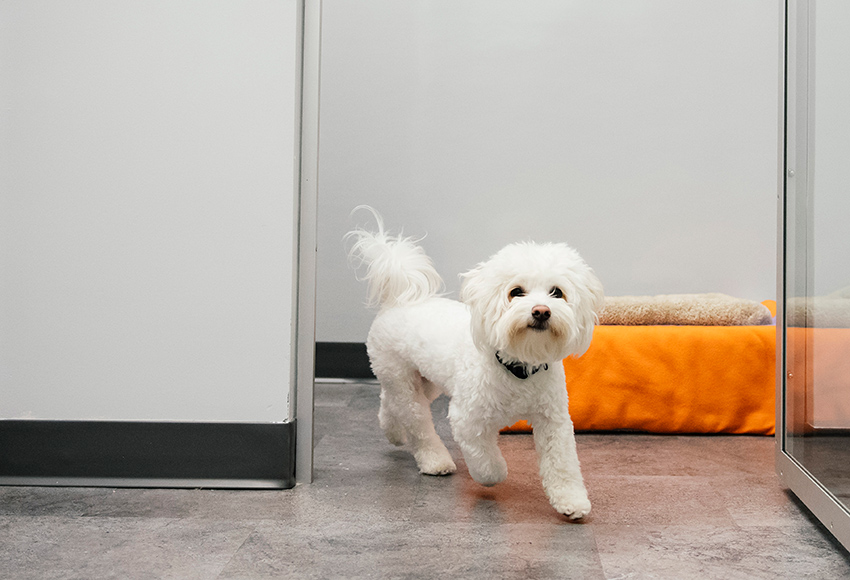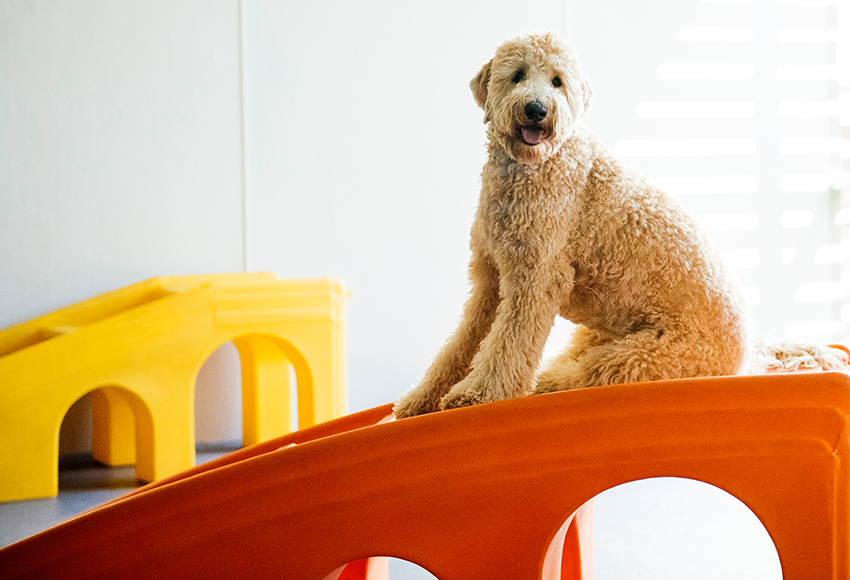Bonding With Your Dog!
August 14, 2018

I love my dog and my dog loves me!?!?
Of course my dog loves me! They wag their tail when they see me, they come running to me, etc. “Love” is a big deal in the human-dog relationship but what about the “bond” between the dog and the pet parent. Love develops with time, but a bond takes work. It requires attention, engagement and time to grow and mature. Love is what makes your dog excited when you come home, while the bond is what keeps them with you when you need them to be. In human terms, you feel love for your relatives, but you share a bond with your best friend. A strong bond forms the key foundation of your entire relationship with your dog.
When we look at human-dog relationships what we tend to see often, is a series of “human-created bond violations” that have weakened the strength of the relationship between the dog and person. Some are major, such as physical punishment or not providing enough exercise, while others are more difficult to pinpoint—a lack of confidence in the relationship or lack of engagement with the dog. For example, basic training certainly can improve these “sparkless” relationships, but we often find weaker training outcomes where we have a weak bond.
In order to have happy, frustration-free partnerships with our dogs, we need more than just love and training. For a relationship that truly thrives, we must cement a bond with our dog, built on trust, mutual respect and regard.
Weak vs. Strong Bond Cues
But of course, our bond with our dog is great! Why wouldn’t it be? Let’s look at a handful of ways we can view whether the bonding is truly as strong as we think it is.
Signs that Your Bond is Weak
Even though you may be a caring, considerate person, your dog might still not feel a close bond with you. Signs of a weak bond include:
- Emotional indifference to you or others in the family. A failure to respond to commands, especially the recall command
- Limited desire to play
- Not fond of being handled
- Regular attempts to run off
- Poor focus and eye contact
- Belligerence or even outright aggression toward you
- Depression or lethargic behavior
Signs of a Strong Bond
There’s no mistaking a dog who feels a real emotional connection with you. There’s a real light in their eyes; they smile, wag, rub into you, and makes great eye contact. When you come home, they brighten up, becomes animated, and may even vocalize their joy. Other signs of a strong bond include:
- Keeping tabs on your location when they are off leash
- Frequently checking in to see where you’re at
- Performing obedience happily without hesitation
- Making a great effort to find you when you play hide-and-seek
- A desire to be near you
- A high level of focus on you, evidenced by frequently looking at you
- Strong ability to communicate needs, wants, and concerns. (Do you understand what your dog wants in almost any given situation?)
- A willingness to protect or help you in a threatening situation. At the same time, time know that a dog can easily slide into guarding so protection by itself doesn’t necessarily equal love.
- A love for physical interaction
- Once taught Come, the dog always responds, even when distracted (This one is tricky even for well-bonded dogs. If you’ve got this down even in the most distracting of circumstances, congratulations!)

How to Improve Bonding With Your Dog
There are basic behaviors that people like to do that do not translate to dogs in a positive way. While dogs clearly do show and seek affection, their “language” tends to be non-verb
al and humans tend to be more verbal. Additionally, our non-verbal behaviors tend to be more intrusive than what most dogs are comfortable with. While every dog is unique and may tolerate the behaviors below in they may not enjoy them. As you do things on the list below know that it can strain the bond that you’re trying to form.
Commands with too many words
It’s fine to have commands but when you get beyond 3 words it’s far too tasking. They are trying to marry body language and verbal and humans aren’t incredibly good at putting them both together. A great experiment is to try to spend a whole day not saying a word to your dog, but communicating only with your body. You’ll realize just how much you “talk” with your body without realizing it, how to use your movements and body position to get the response you need from your dog during training, and how involved a conversation can be without emitting a single sound.
Hugging your dog
While you might love wrapping your arms around a furry canine friend, most dogs hate hugs. Dogs don’t have arms and they don’t hug. If a dog places a foreleg or paw on the back of another dog, this is considered an act of control. No matter your intentions with hugging, a dog is likely to feel uncomfortable during the embrace.
Petting a dog’s face or patting her head
Having someone reach out and tap us on the head, no matter how lovingly, is not something most of us enjoy. Ideally, it’s best to come in under the chin so they know they can easily withdraw if they are uncomfortable. However, in most cases pet parents have to work a little harder to let their pups know that this “uncomfortable” touch equals love in the human world.
Kisses
Dog’s use their tongue lick as a sign of submission, not love. You should never demand a kiss from your dog since all you’re doing is forcing dominance on your dog. Many dogs like to lick and kiss (especially when greeting other pack mates and grooming). Read the body language of your dog, do they wag and comply? Do they get nervous?, etc. The best strategy is to let them initiate vs. asking for kisses.
Picking them up like a baby
Picking your dog up is fine but as soon as you turn them over and put them upside-down above the ground you’re increasing their anxiety. Keep them paws down and you’ll have a happier pup.
Prolonged eye contact
The more familiar you are with a dog the more you can maintain steady eye contact. Just like people, having a stranger stare at you turns creepy fast, the same is true from a dog’s perspective.
Approaching a dog in a way that is comfortable for both of you is to approach with your body angled slightly (not with your shoulders squared toward the dog), your eyes slightly averted, and speak quietly with a gentle voice. All these body language cues of friendship will help a dog understand you mean no harm. The dog might still want nothing to do with you, but at least you didn’t approach him/her in a scary way that could cause a defensive or aggressive reaction.
Not providing structure and rules
Dogs want, need and love rules. You might think having strict rules makes life boring or unhappy for your dog. But dogs really want to know what’s what according to their leader. Rules make life a lot more predictable, a lot less confusing and a lot less stressful. They also don’t understand exceptions to rules. Dogs thrive when they know where the boundaries are, and when you spend time enforcing consistent boundaries with positive rewards, you also are building up their trust in you as a leader. You’re setting up conditions for a very happy dog!
Forcing your dog to interact with dogs or people he/she clearly doesn’t like
Just like so many other social species, dogs have their favorite friends and their enemies. It is easy to see what other dogs — and people, for that matter — that a dog wants to hang out with and those with whom she’d rather not associate. When dogs are pushed too far in social situations, they’re more likely to lash out with a fight or a bite.
Going for walks without the opportunity to explore and smell (hasty walks)
There are walks, and there are walks. It’s definitely important to have a dog that knows how to walk obediently on a leash. However, it’s also important to allow a dog to have some time to explore their surroundings while walking obediently on a leash. Dogs see with their noses, and they place as much importance on their sense of smell as we humans place on our sense of vision for interpreting the world around us.
Keeping a tight leash (literally)
Just as dogs are amazing at reading our body language, they’re amazing at reading our tension levels even through the leash. By keeping a tight leash on a dog, you’re raising the level of stress, frustration, and excitement for your dog, and conversely, for you.
Being boring
Dogs abhor it when we’re boring. And it’s hard not to be! We get home from work and we want to unwind, to get a few chores done, to make dinner and sack out on the couch and relax. But that’s about the most annoying thing we could do to our dogs who have been waiting around all day for us to finally play with them. Consider using toys more as playtime or find a good doggie daycare as an outlet and change of pace.
Teasing
This should be obvious, but it’s worth pointing out because too many people still think it’s funny. Don’t bark at a dog as you pass it on the street. Don’t wave or talk to a dog that is barking at you from behind a window or door. Don’t pull on a dog’s tail. The list can go on and on, but in short, don’t do something you know makes a dog mad just because you think it’s funny
Dressing them up
Yes, they look cute but when they have to wear apparel that they aren’t comfortable with it doesn’t help build the bond. You know if your dog loves a bandana, sweater, etc. However, you also know when they are wearing something for you and if they don’t like it. Err on the dog’s side when choosing apparel.
Forcing them in scary situations
We sometimes have to bring our pets into unfamiliar circumstances but whenever possible try and not put them in scary situations. Nobody wants to go down that “dark alley” if it’s not necessary. If you know you will be taking your pup into unknown territory, tale along some treats for positive reinforcement.
Strong Smells/Fragrances
What you smell as one cinnamon roll they smell a million. The same goes for that splash of perfume, cologne, etc. Go light on the fragrances and your pet will thank you.
Too much alone time
No surprise but being alone, even loose in the house, isn’t fun if there’s nobody to play with. Carve out the time or find ways to have your pup play with other pups and people. Again, doggie daycare is a great option to provide more entertainment for your pup.
Asserting dominance by leaning over a puppy
Hovering over another dog is a way to demonstrate control, the same is true for humans. Side by side engagement is far better than the stand/kneel and hover move.
Sometimes you are in a hurry and you need them to go. Consistently hurrying them to go to the bathroom though doesn’t allow them the time they would like to smell for the appropriate place to go as well as give them a few minutes to “warm up.” If you’re not in a hurry let them have the extra time.
Remain calm
Yelling, screaming and throwing a temper tantrum will frighten most dogs, even if that anger isn’t directed at them personally. And if it is, then it’s even more damaging. Do your best to always speak to your dog in a calm voice, even when they just ate your favorite shoes. Yelling doesn’t do anything to fix the problem, it only causes lasting damage to the relationship you have with your dog.







